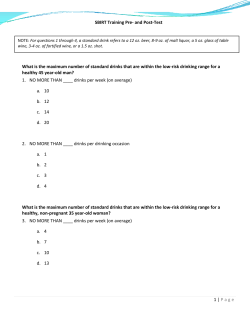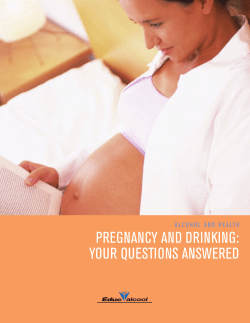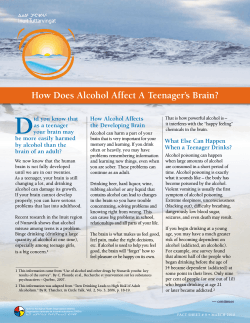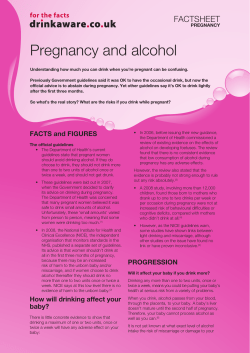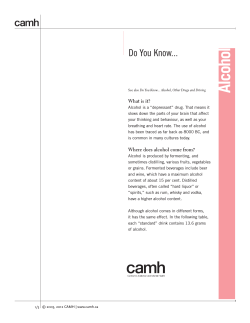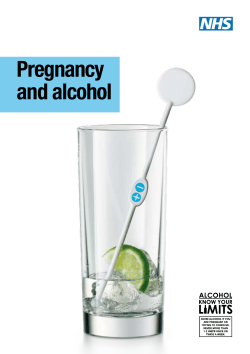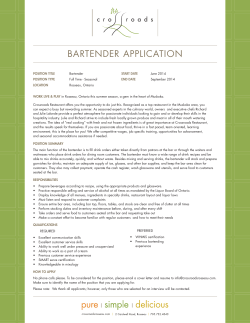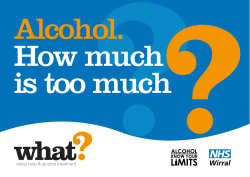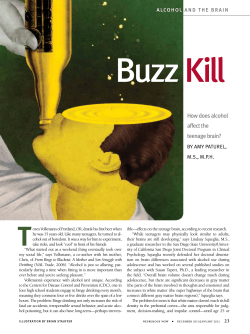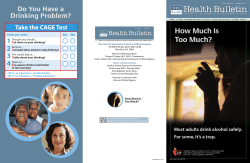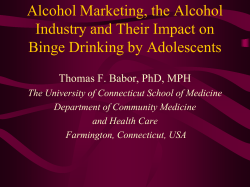
4 Screening for alcohol consumption in pregnancy
4 Screening for alcohol consumption in pregnancy A mechanism for use in the clinical setting 4.1 Screening instruments for alcohol consumption in pregnancy When women are asked about alcohol use during pregnancy the amount of information recorded is limited and there is usually no detailed information on the dose, pattern, and timing of prenatal alcohol consumption.112 A number of instruments exist to assess alcohol intake in pregnancy, mainly designed to identify women who drink at high levels. Some of the most common are the T-ACE (Tolerance, Annoyed, Cut Down, Eye Opener),113 TWEAK (Tolerance, Worry, Eye Opener, Amnesia, Cut Down),40 and AUDIT (Alcohol Use Disorders Identification Test).25 The T-ACE and TWEAK have been validated for use with pregnant women but focus on identifying heavy drinkers. The AUDIT which includes questions related to frequency, quantity and binge drinking has not been specifically developed to screen for drinking in pregnancy. It has however, been validated in pregnant women in the United States114 but not in Australia. A recent systematic review of prenatal screening instruments to identify high risk drinking in pregnancy estimated that the TWEAK, T-ACE and AUDIT-C (the latter using only the three consumption questions of AUDIT) had the highest sensitivity in detecting risk drinking with tests identifying around seven to nine heavy drinkers out of ten.10 This high sensitivity on the other hand, resulted in a high rate of false positives, indicating that for every woman identified correctly, as many as three women could be identified as drinking at risky levels when they are not. Table 5 (page 59-60) presents a list of alcohol screening instruments most commonly used in pregnancy to detect high levels of drinking. 4.2 Clinical tools to address alcohol consumption in pregnancy Given that adverse outcomes leading to Fetal Alcohol Spectrum Disorders cannot always be completely explained simply by whether the woman has a history of drinking alcohol or not,115 some studies recommend the use of a validated screening instrument in combination with additional embedded components providing more accurate information on dose and frequency as well as factors such as smoking, that contribute to a maternal risk score.44 45 One such example is the prenatal care and risk reduction assessment tool for use in clinical practice developed by Dr Larry Burd at the North Dakota Fetal Alcohol Syndrome Center.(http://www.online-clinic.com/Content/Tools/AssessmentTools/QuadCalc.asp)44 This assessment is a complete interactive clinical tool which, given time and inclination of the general practitioner, would be of great benefit in clinical practice. The tool screens for alcohol use (TWEAK), determines consumption patterns and includes a measure of a maternal risk score, but it also provides clinicians with a means to discuss an alcohol risk reduction strategy. 56 Although not done routinely in Australia, assessment of alcohol consumption in pregnancy is an important public health approach and aspect of antenatal care. There is evidence that if combined with a brief intervention, in the form of education and support, screening for risk drinking in pregnancy can result in reduced alcohol consumption.116 An initiative by the Telethon Institute in Western Australia has developed such a resource making use of AUDIT followed by a brief intervention consisting of; a) establishment of the desire to want to change drinking behaviour; b) education regarding the benefits of ceasing or reducing alcohol consumption ;and c) goal setting (http://www.ichr.uwa.edu.au/alcoholandpregnancy). This resource has been further developed by the Lifescripts Demonstration Divisions Project, Commonwealth Department of Health and Ageing (http://www.health.gov.au/lifescripts). Given the advanced production and the high quality content of the Pregnancy Lifescripts Kit, containing resources on alcohol and smoking, these materials are ideal for use in general practice and by maternity clinicians. Specifically, the Alcohol and Pregnancy Lifestyles Kit contains an evidence based guide for health care professionals about the screening process, a three-question validated screening instrument (AUDIT-C) and an intervention strategy, including goal setting. This kit reflects the current evidence on screening for alcohol and mode of intervention. Lifescripts has an established mechanism for distribution through the Australian General Practice Network (AGPN). Alcohol and Pregnancy Lifestyles is currently under revision to reflect the most recent NHMRC guidelines regarding safe levels of alcohol consumption during pregnancy23 and will also soon be available in electronic format compatible with existing primary health care desktop interfaces (please see page 61-65 for a copy of the materials currently under revision). 4.3 Conclusion Alcohol screening instruments used in clinical practice focus on identifying at risk drinkers and are not designed to quantify actual amounts of alcohol consumed. There are a number of validated screening instruments specific to pregnant women and a recent systematic review of these instruments identified three that show acceptable sensitivity in this population, namely the T-ACE, TWEAK and AUDIT-C.10 While there are some policy statements in Australia recommending that pregnant women should be asked about alcohol, and that high risk drinkers should receive brief interventions,117 there are currently no clear guidelines for general practitioners and maternity care providers as to how pregnant women should be asked about their alcohol consumption and given information on the risk associated with drinking during pregnancy. 57 4.4 Recommendation We propose that women should be screened for alcohol intake with a validated clinical instrument that preferably includes some assessment of consumption patterns, accompanied by clear instructions for the practitioner on how to interpret and discuss the information and handouts of educational material for the woman. A mechanism for this is in place in Australia through the Lifescripts Demonstrations Divisions Project at the Commonwealth Department of Health and Ageing. 58 Table 5 Examples of the most common prenatal alcohol screening instruments Questionnaire Time focus Frequency Quantity Binge Other How many times a week do you drink? (asked separately for beer, wine, liqueur) How many cans/glasses/drinks do you have at one time? (asked separately for beer, wine, and liqueur) Do you ever drink more? (asked separately for beer, wine, and liqueur) But: not questions as to how much! Has your drinking changed over the past year? Prenatal Yes Yes Yes Not designed for pregnancy; tested in pregnancy (not AUS) How often do you have a drink containing alcohol? Options: never, monthly or less, 2 to 4 times/month, 2 to 3 times/wk, 4 or more times/wk How many drinks containing alcohol do you have on a typical day when you are drinking? Options: 1 or 2, 3 or 4, 5 or 6, 7 to 9, 10 or more How often do you have 6 or more drinks on one occasion? Options: never, less than monthly, monthly, weekly, daily or almost daily AUDIT-C AUDIT consumption questions Not designed for pregnancy; tested in pregnancy (not AUS) How many drinks did you have on a typical day when you were drinking in the past year? Options: 1 or 2, 3 or 4, 5 or 6, 7 to 9, 10 or more How often did you have 6 or more drinks on one occasion during the past year? Options: never, less than monthly, monthly, weekly, daily or almost daily T-ACE Tolerance Annoyed Cut down Eye-opener Prenatal How often have you had a drink containing alcohol in the past year? Options: never, monthly or less, 2 to 4 times/month, 2 to 3 times/wk, 4 or more times/wk No No No How many drinks does it take to make you feel high? Have people annoyed you by criticising your drinking? Have you ever felt you ought to cut down on your drinking? Have you ever had a drink first thing in the morning to steady your nerves or get rid of a hangover? Prenatal No No No Do you feel you are a normal drinker? Have you ever had a drink first thing in the morning to steady your nerves or to get rid of a hangover? (eye-opener) How many drinks does it take to make you feel high? Prenatal No No No Prenatal How many times per week are you drinking now? How many cans/glasses/drinks each time? Ever drink more - like more on the weekend? If yes: How much do you have then? How many drinks can you hold? Have close friends or relatives worried or complained about your drinking in the past year? Do you sometimes take a drink in the morning when you get up? Has a friend or family member ever told you about things you said or did while you were drinking that you could not remember? Do you sometimes feel the need to cut down… drinking? The first question has to do with your family. Has anyone in your family ever had a drinking problem? If yes: tell me about that... Alcohol screening instruments TQDH Ten Question Drinking History Prenatal 118 Specifically developed to detect FAS risk. Binge drinkingnot captured properly TLFB Time Line Follow Back (a woman drinking more than 4 drinks once a week or more is considered at risk and needs further evaluation) 119-121 Nurse administered recall diary completed at each antenatal visit. No information on personal or family history, tolerance AUDIT Alcohol Use Disorders Identification Test 25 114 122 Also asks about alcohol related problems, but designed to detect hazardous and dependent drinking 10 123 113 120 Detects high level drinking. Tolerance question NET (1 MAST item, 1 CAGE item and 1 TACE item) 124 Detects high level drinking. Tolerance question TWEAK Tolerance Worried Eye-opener Amnesia Cut down 125-127 Detects high level drinking. Tolerance question. PAUI Prenatal alcohol use interview 42 7 questions about impact of drinking AUS gov has 2 extra Qs: Do you think you presently have a problem with drinking? In the next 3 months, how difficult would you find it to cut down or stop drinking? 59 Includes family and personal history, tolerance, binge questions and TQDH (13 Qs) 4 P's Plus Parents, Partner, Past, Pregnancy Prenatal In the month before you knew you were pregnant, how many beers/ how much wine/ how much liqueur did you drink? See previous column No Not tested in pregnancy, validated in women Q1: On average in the last 12 months (or 90 days), how many days per week did you drink alcohol? Number of days/week. Q2: When you did drink alcohol, on average, how many standard drinks would you have had in a day? How many times in the past 12 months (or 90 days) have you had 5 or more standard alcoholic drinks on one occasion? (definition of standard drink provided). 128 129 Not specific but includes partner history QDS Quick Drinking Screen 130 131 Also: Multiply answer from Q 1 with answer from Q2 to get quantity measure. BMAST Brief Michigan Alcoholism Screening Test Not designed for pregnancy, validated in women No No Not designed for pregnancy How often did you drink any alcoholic beverage, eg….. Options: Every day, nearly every day, 3 to 4 times /wk, 1 to 2 times/wk, 2 to 3 times/mth, Once a mth, 7 to 11 times in the past year, 4 to 6 times in the past year, 2 or 3 times in the past year, once in the past year, Never in past year, never in my life How many drinks did you usually have on days when you drank. By drink, I mean the equivalent of a 330 ml glass, can, or bottle of beer or cooler, a 200 ml glass of wine, or 40 ml glass of spirits, not counting any mixer, water, or ice. Not designed for pregnancy How often did you drink x drinks (refer to quantity column) of any type of alcoholic beverage on a single day Options: Every day, nearly every day, 3 to 4 times /wk, 1 to 2 times/wk, 2 to 3 times/mth, Once a mth, 7 to 11 times in the past year, 4 to 6 times in the past year, 2 or 3 times in the past year, once in the past year, Never in past year * ‘How often’ question asked 5 times with no. of drinks: options: 12 or more, 8 to 11, 5 to 7, 3 to 4, 1 to 2 What was the greatest number of standard drinks you consumed in one day? No 127 132 Focus on lifetime use, harmful levels, consequences of drinking WHO International guide for monitoring alcohol consumption & related harm 3 questions module 24 Has quantity and frequency of consumption measures WHO International guide for monitoring alcohol consumption & harm 8 questions module 24 Has quantity and frequency of consumption measures 60 In the past year, how often did you drink 5 or more drinks of any alcoholic beverage, or combination of beverages, in a single day? Options: Every day, nearly every day, 3 to 4 times /wk, 1 to 2 times/wk, 2 to 3 times/mth, Once a mth, 7 to 11 times in the past yr, 4 to 6 times in the past year, 2 or 3 times in the past year, once in the past year, Never in past year Counting all types of beverages combined, what was the LARGEST number of drinks that you drank in a single day during the past year? How old were you when you first got drunk? Did you get into trouble because of drinking? How much could you hold at that time? (or, How many drinks does it take to make you high?) When did you have a drink last? What did you drink? How many (cans, glasses, drinks) did you have then? How many times per week before you were pregnant? Did either of your parents ever have a problem with alcohol or drugs? Does your partner have a problem with alcohol or drugs? Have you ever drunk beer, wine or liqueur? In the month before you knew you were pregnant, how many cigarettes did you smoke? Æ This Q was left out in Dum et 130 al, reducing the screener to 3 questions, plus one derived measure. Do you feel you are a normal drinker? Do your friends or relatives think you are a normal drinker? Have you ever attended a meeting of AA? 7 more questions about problems resulting from drinking eg lost friends, trouble at work, hospitalisation Several versions available (MAST, SMAST, BMAST) Ever drunk alcohol: 2 preliminary Qs establishing whether respondent has ever drunk alcohol, and if so whether they have drunk any during the past year 4.5 Alcohol and Pregnancy Lifescripts Kit (under revision, March 2010) 61 62 63 64 65
© Copyright 2025
